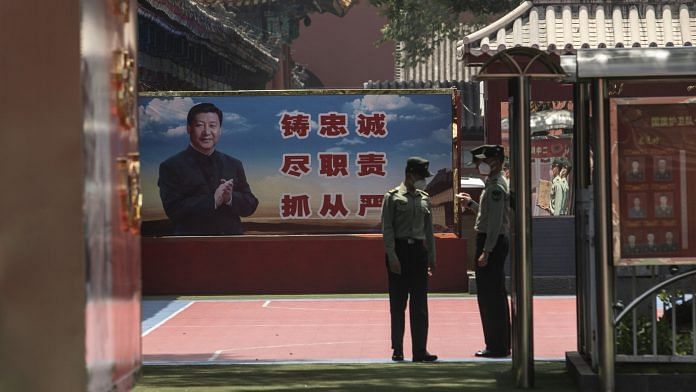China has attacked Indian media for spreading “fake news” about events in Arunachal Pradesh. But it merely reveals China’s frustration over its inability to control the narrative.
On 8 October, News18, citing unnamed “government sources” in India, reported that Indian soldiers “briefly detained” some PLA troops in Arunachal Pradesh’s Tawang. China’s response suggests the People’s Liberation Army was rattled by the report. Chinese state media – including China Daily – and others called the report “false” citing unnamed PLA sources.
China has refrained from officially commenting on the incident. “I am not aware of relevant information,” said Chinese foreign ministry spokesperson Zhao Lijian. But the Chinese state media gave the official response through editorials with no byline – among other actions.
“Indian media recently spread rumors and hyped (that) ‘PLA soldiers are crossing the border in the border area’. However, according to Chinese military sources, the Indian media’s hype is false and inconsistent with the facts. In fact, this is a routine patrol of our border troops on the border of our country,” said an editorial published by Science and Technology outlet of the People’s Daily. The newspaper had commented only a few times on the Ladakh stand-off last year.
Also read: China sees ‘snub’ to India in Bhutan agreement. And Chinese are mocking Ajay Devgn
Controlling the narrative
Tensions between India and China at the Line of Actual Control (LAC) had calmed down since February 2021 when both sides started disengaging. But with several rounds of military-level talks ending in a stalemate, border tensions are inching back towards 2020 levels. There was no progress at the 13th round of border talks in Moldo, which took place on 10 October. PLA Western Theatre Command spokesperson Senior Colonel Long Shaohua called India’s demands at the talk “unreasonable and unrealistic”.
‘India’s unreasonable request adds difficulties to the negotiation’ was a leading trend on Chinese microblogging website Weibo. The trend was viewed 90 million times.
China fell back on leaked images and a coordinated propaganda campaign to counter the Indian media report. PLA leaked videos on Weibo to counter the report. One video purportedly showing an Indian soldier blindfolded and under detention was particularly shared by state media journalists. It is unclear when the event took place.
A series of old videos of patrolling encounters along the LAC were also posted on Weibo to create an impression these were new incidents. The PLA uniforms in these videos were from the pre-military reform period.
Chinese experts aren’t even concealing the fact that pictures on social media were leaked in response to the Indian media report on Arunachal Pradesh.
“What is the result of India’s provocative behaviour? It is manifested clearly,” Lin Mingwang, professor, and assistant dean at the Institute of International Studies at Fudan University, said in response to a question about the timing of the leaks.
Also read: China wants to tame Internet algorithms. It’s all about national security
A visit that triggered China
The Chinese foreign ministry had opposed Vice President Venkaiah Naidu’s visit to Arunachal Pradesh. “Chinese government never recognised the so-called ‘Arunachal Pradesh’,” said Zhao Lijian. India rarely comments on the visit of Chinese leaders to border areas. The Ministry of External Affairs (MEA) didn’t comment on Chinese President Xi Jinping’s recent visit to Nyingchi, which is less than 20 km away from the McMahon Line.
Zhao Lijian’s statement on Arunachal Pradesh started a trend on Weibo, which was extensively discussed on other Chinese social media platforms as well.
The Communist Party-affiliated Guizhou Communist Youth League posted pictures of PLA soldiers from an unknown location with the hashtag ‘China never recognised Arunachal Pradesh’, which was viewed 390 million times on Weibo.
“On a plateau of four or five kilometers, on the border of the motherland, and out of our sight, they stood silently, fought tenaciously, and promised the country by themselves. They worked hard, salute! Great rivers and mountains, not letting an inch of land,” said the post by Guizhou Communist Youth League, which has 1.7 million followers on Weibo.
“It is known that Southern Tibet is easy to attack and difficult to defend because of its terrain. After fighting for two months in the Sino-Indian War in the 1960s, the PLA retreated after winning the battle. The ultimate goal was to exchange absolute control of Tibet and stabilize Tibet. The issue of southern Tibet comes after Taiwan,” said a Weibo user.
Chinese experts have blamed India’s “forward policy”. “In the past few decades, India has always adopted a forward policy and a policy of cannibalization in the Sino-Indian border area, believing that ‘occupation is possession’. In fact, China cherishes and values China-India relations very much. We hope that China and India can get along with each other in friendship, form cooperation, and resolve border issues peacefully through negotiations,” wrote Shanghai Institute of International Studies scholar Liu Zongyi in an article in China Daily.
The Chinese state media even used the Bhutan-China agreement to gain an “upper hand” in information warfare against India.
“At a time when India is pursuing hegemony by coercion over its neighbors, the MoU is a victory for the region,” said a CGTN editorial that didn’t have a byline.
On the one hand, unnamed PLA sources said the incident took place on their side of the border; on the other hand, Zhao Lijian has stated China “never recognised Arunachal Pradesh”.
There is much contradiction in China’s stance about the recent events. But we can say with certainty that China has no intention of going back to the pre-2020 status quo at the LAC. China believes that it can drag the border stand-off on by deploying its media apparatus.
The author is a columnist and a freelance journalist. He was previously a China media journalist at the BBC World Service. He tweets @aadilbrar. Views are personal.
(Edited by Prashant)



